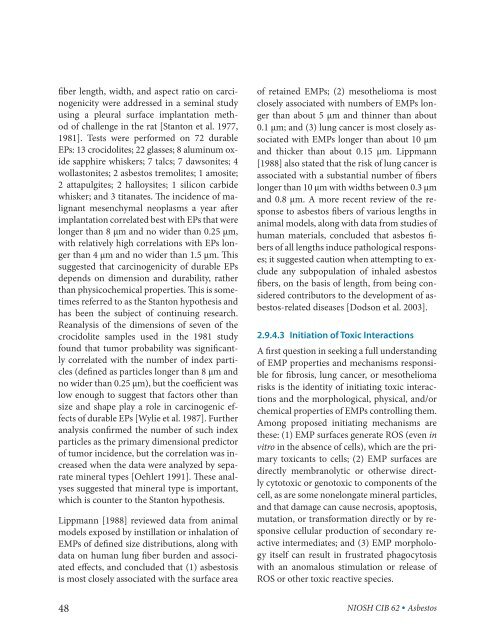Asbestos Fibers and Other Elongate Mineral Particles: State of the ...
Asbestos Fibers and Other Elongate Mineral Particles: State of the ...
Asbestos Fibers and Other Elongate Mineral Particles: State of the ...
- No tags were found...
You also want an ePaper? Increase the reach of your titles
YUMPU automatically turns print PDFs into web optimized ePapers that Google loves.
fiber length, width, <strong>and</strong> aspect ratio on carcinogenicity<br />
were addressed in a seminal study<br />
using a pleural surface implantation method<br />
<strong>of</strong> challenge in <strong>the</strong> rat [Stanton et al. 1977,<br />
1981]. Tests were performed on 72 durable<br />
EPs: 13 crocidolites; 22 glasses; 8 aluminum oxide<br />
sapphire whiskers; 7 talcs; 7 dawsonites; 4<br />
wollastonites; 2 asbestos tremolites; 1 amosite;<br />
2 attapulgites; 2 halloysites; 1 silicon carbide<br />
whisker; <strong>and</strong> 3 titanates. The incidence <strong>of</strong> malignant<br />
mesenchymal neoplasms a year after<br />
implantation correlated best with EPs that were<br />
longer than 8 µm <strong>and</strong> no wider than 0.25 µm,<br />
with relatively high correlations with EPs longer<br />
than 4 µm <strong>and</strong> no wider than 1.5 µm. This<br />
suggested that carcinogenicity <strong>of</strong> durable EPs<br />
depends on dimension <strong>and</strong> durability, ra<strong>the</strong>r<br />
than physicochemical properties. This is sometimes<br />
referred to as <strong>the</strong> Stanton hypo<strong>the</strong>sis <strong>and</strong><br />
has been <strong>the</strong> subject <strong>of</strong> continuing research.<br />
Reanalysis <strong>of</strong> <strong>the</strong> dimensions <strong>of</strong> seven <strong>of</strong> <strong>the</strong><br />
crocidolite samples used in <strong>the</strong> 1981 study<br />
found that tumor probability was significantly<br />
correlated with <strong>the</strong> number <strong>of</strong> index particles<br />
(defined as particles longer than 8 µm <strong>and</strong><br />
no wider than 0.25 µm), but <strong>the</strong> coefficient was<br />
low enough to suggest that factors o<strong>the</strong>r than<br />
size <strong>and</strong> shape play a role in carcinogenic effects<br />
<strong>of</strong> durable EPs [Wylie et al. 1987]. Fur<strong>the</strong>r<br />
analysis confirmed <strong>the</strong> number <strong>of</strong> such index<br />
particles as <strong>the</strong> primary dimensional predictor<br />
<strong>of</strong> tumor incidence, but <strong>the</strong> correlation was increased<br />
when <strong>the</strong> data were analyzed by separate<br />
mineral types [Oehlert 1991]. These analyses<br />
suggested that mineral type is important,<br />
which is counter to <strong>the</strong> Stanton hypo<strong>the</strong>sis.<br />
Lippmann [1988] reviewed data from animal<br />
models exposed by instillation or inhalation <strong>of</strong><br />
EMPs <strong>of</strong> defined size distributions, along with<br />
data on human lung fiber burden <strong>and</strong> associated<br />
effects, <strong>and</strong> concluded that (1) asbestosis<br />
is most closely associated with <strong>the</strong> surface area<br />
48<br />
<strong>of</strong> retained EMPs; (2) meso<strong>the</strong>lioma is most<br />
closely associated with numbers <strong>of</strong> EMPs longer<br />
than about 5 µm <strong>and</strong> thinner than about<br />
0.1 µm; <strong>and</strong> (3) lung cancer is most closely associated<br />
with EMPs longer than about 10 µm<br />
<strong>and</strong> thicker than about 0.15 µm. Lippmann<br />
[1988] also stated that <strong>the</strong> risk <strong>of</strong> lung cancer is<br />
associated with a substantial number <strong>of</strong> fibers<br />
longer than 10 µm with widths between 0.3 µm<br />
<strong>and</strong> 0.8 µm. A more recent review <strong>of</strong> <strong>the</strong> response<br />
to asbestos fibers <strong>of</strong> various lengths in<br />
animal models, along with data from studies <strong>of</strong><br />
human materials, concluded that asbestos fibers<br />
<strong>of</strong> all lengths induce pathological responses;<br />
it suggested caution when attempting to exclude<br />
any subpopulation <strong>of</strong> inhaled asbestos<br />
fibers, on <strong>the</strong> basis <strong>of</strong> length, from being considered<br />
contributors to <strong>the</strong> development <strong>of</strong> asbestos-related<br />
diseases [Dodson et al. 2003].<br />
2.9.4.3 Initiation <strong>of</strong> Toxic Interactions<br />
A first question in seeking a full underst<strong>and</strong>ing<br />
<strong>of</strong> EMP properties <strong>and</strong> mechanisms responsible<br />
for fibrosis, lung cancer, or meso<strong>the</strong>lioma<br />
risks is <strong>the</strong> identity <strong>of</strong> initiating toxic interactions<br />
<strong>and</strong> <strong>the</strong> morphological, physical, <strong>and</strong>/or<br />
chemical properties <strong>of</strong> EMPs controlling <strong>the</strong>m.<br />
Among proposed initiating mechanisms are<br />
<strong>the</strong>se: (1) EMP surfaces generate ROS (even in<br />
vitro in <strong>the</strong> absence <strong>of</strong> cells), which are <strong>the</strong> primary<br />
toxicants to cells; (2) EMP surfaces are<br />
directly membranolytic or o<strong>the</strong>rwise directly<br />
cytotoxic or genotoxic to components <strong>of</strong> <strong>the</strong><br />
cell, as are some nonelongate mineral particles,<br />
<strong>and</strong> that damage can cause necrosis, apoptosis,<br />
mutation, or transformation directly or by responsive<br />
cellular production <strong>of</strong> secondary reactive<br />
intermediates; <strong>and</strong> (3) EMP morphology<br />
itself can result in frustrated phagocytosis<br />
with an anomalous stimulation or release <strong>of</strong><br />
ROS or o<strong>the</strong>r toxic reactive species.<br />
NIOSH CIB 62 • <strong>Asbestos</strong>

















